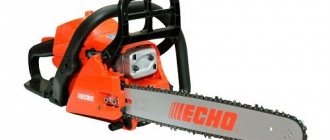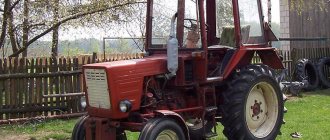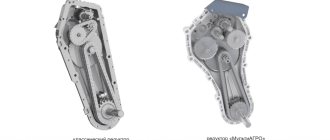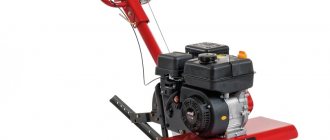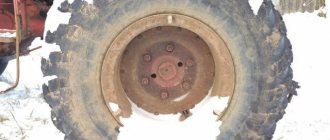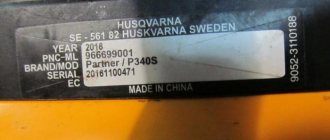What kind of unit is this
KSM-4 is used for planting potatoes over large areas. Productivity - from 1.2 to 3.2 hectares per hour.
The planter is used together with a tractor of the following type:
- LTZ-60;
- YuMZ-6;
- Belarus-921;
- MTZ-80;
- MTZ-82;
A dump truck or tractor trolley are also suitable. The planter is serviced by 1 tractor driver and 1 agricultural worker. The device is connected to the power take-off shaft and hydraulic system of the leading tractor.
What does it look like
The basis of the planter is a rigid frame welded from a metal profile on which all mechanisms are mounted.
In the front part there are:
- trailer beam;
- hydraulic system high pressure hose;
- electrical equipment plug connected to the tractor socket.
Next in order are:
- front metal wheels;
- 2 bunkers for fertilizer spreading devices with platforms in front of them;
- discs covering the tubers and forming the ridge;
- rear pneumatic wheels;
- main and loading bunkers.
The loading hopper in the photo above is raised to its highest position. The unit is in transport position, prepared for going to the field.
This is interesting:
How to make a two-row potato planter yourself.
How to make a potato planter for a mini tractor with your own hands.
Principle of operation
After the dump truck loads the potatoes into the loading hopper, they are lifted by hydraulic cylinders. Fertilizers are loaded into the box of fertilizer sowing machines.
When the planter moves, the tubers from the main hopper, with the help of shakers and turners, flow through the valve into the nutrient bucket. The auger sowing mechanism picks up one tuber at a time with spoons and feeds it to the reflector shield. He sends the vegetables further into the furrow from the opener. Next, depending on the type of landing - ridge or smooth - when setting up, either discs (to create a ridge) or harrows (for a smooth landing) are installed.
Important! Fertilizer is applied into the gap behind the coulter. There are slits in its cheeks through which the earth covers the granules.
The soil layer, compacted by the tractor wheels, is loosened by a spring-loaded ripper installed in the front of the potato planter.
Four-row potato planter KSM for tractor 80-100 hp
Device
Judging by the design, the models of potato planters are not much different from each other. In principle, the device itself is quite simple, which can be attached to a walk-behind tractor (see here) or to a mini tractor (see here), so many craftsmen have adapted to making home-made units (more details here) that have exactly the same principle of operation.
Structurally, the potato planter looks like this:
- frame structure on which other elements of the device are located;
- container in which the planting potatoes are located;
- a mechanism for planting potato tubers, which is driven by gears;
- rippers that form holes;
- disk elements that fill the holes after planting tubers in them;
- wheelbase.
This is a fairly typical list of what is included in a potato planter. Depending on the configuration, the design can be supplemented with a tank and a fertilizer dispenser, as well as an additional hopper for planting potatoes (you can read more about such a device as a potato planter for a walk-behind tractor here).
If you are interested in chainsaws, then you will be interested in reading about Russian-made chainsaws.
One of the most popular Russian chainsaws is the Druzhba chainsaw. You can read about it in one of our articles.
Also from our articles you will learn about the Lesnik chainsaw, also made in Russia.
Specifications
KSM-4 is intended for planting potatoes on all types of soils, in all crop cultivation zones.
Equipment characteristics:
- four-row planter, semi-mounted;
- works together with tractors of class 1.4;
- loaded into the field from a dump truck or dump tractor trolley;
- operating speed - 4–10 km/h;
- transport speed - 20 km/h;
- dimensions in working condition - 4200 x 4500 x 2650 mm;
- dimensions in transport position - 4750 x 4500 x 3000 mm;
- main bunker capacity - 1500 kg;
- row spacing - 70, 75, 90 cm;
- planting depth - 5–15 cm;
- productivity: with a row spacing of 70, 75 cm - 1.2–2.4 ha/hour (main time), at 90 cm - 1.8–3.2 ha/hour (main time);
- the dose of mineral fertilizers is 50–400 kg/ha.
Description
The potato planter includes the following components and mechanisms:
- metal frame with trailer;
- 2 front metal and 2 rear pneumatic hydraulically controlled running wheels;
- interconnected main and loading bins;
- 2 landing sections;
- 2 disc sowing units with a common capacity for granular fertilizer;
- motion stabilizer;
- rippers;
- drive via PTO (power take-off shaft);
- 2 hydraulically controlled markers with locking and switching mechanism.
Operating rules
Preparing for work:
- Attach the potato planter trailer beam to the tractor hitch and secure it.
- Secure the power take-off shaft.
- Combine the hydraulic line of the potato planter and the hydraulic system of the tractor.
- Plug the unit's electrical equipment into the tractor socket.
- Check hydraulic and electrical equipment for functionality.
- Turn on the power take-off shaft and visually check the operation of the mechanisms.
Operating procedure:
- Drive into the furrow.
- Load the planter with seed into the lowered hopper. To do this, drive up close and unload the tubers.
- Load the hoppers of fertilizer sowing machines manually or using vehicle mechanisms.
- Raise the feed hopper, lower the coulters to the set depth, turn on the power take-off shaft and start working.
When turning or backing up, be sure to turn off the PTO and raise the potato planter to the transport position.
Setup and adjustment
Setup in preparation for work includes:
- adjustment of the inter-row distance is carried out by moving the planting devices along the rear beam of the frame until the holes are aligned and then secured with bolts;
- setting the landing rate - is done by selecting the drive gear sprockets from the PTO;
- setting the sowing rate for mineral fertilizers.
In the field, the following is performed:
- setting the loading level of the feeder bucket;
- adjustment of coulter depth - set by changing the position of the gauge wheel along the sector;
- adjusting the depth of potato planting is done by changing the angle of inclination of the axle shafts of the furrow closing discs;
- adjusting the angle of entry of the coulters into the soil - the gap is set between the rear edge of the lower edge of the coulter and its nose, changed by rotating the upper link;
- adjustment of fertilizer sowing mechanisms - the gap between the bottom of the bunker and the augers is adjusted by moving the funnels relative to the holes.
Where to buy and how much it costs
The price of potato planters varies within different limits. New ones cost from 381,000 to 1,000,000 rubles, used ones - from 130,000 rubles.
New units are sold in agricultural equipment stores:
- (there are branches in 10 federal districts);
- Internet portal "Agroserver";
- Mercatus LLC.
Advantages and disadvantages
The KSM-4 potato planter is a unit whose design is effective and proven in practice. During the existence of the equipment, a number of modifications were made to eliminate weak points, for example, manufacturers began to use a more reliable imported gearbox, and plastic spoons were replaced with metal ones.
The equipment is designed for simultaneous planting of potatoes and application of fertilizers over large areas in a short time. Provides a specified distance between rows and tubers. The depth of planting and embedding of tubers is carried out according to the agronomic norm of ±4 cm.
For planting in a field littered with stones, the KSM-4-I potato planter with a coulter protection mechanism is suitable.
The disadvantage of the unit is its sensitivity to the size of the planting material. You first have to sort the tubers by size (35–60 mm, 65–95 mm and more than 100 mm) and plant them in turn. Next, the device is reconfigured and the spoons are changed to a different size. Otherwise, there may be large gaps between tubers, damage to the planting material, or the introduction of 2 vegetables at once.
Tips and tricks
Despite the simplicity of the design, in order for the assembled unit to work, individual components and parts require extreme care .
Thick wire should be wound with the expectation that rings cut from it for grips will increase slightly in diameter when attached to chain links. Therefore, the pipe on which the wire will be wound must have a smaller diameter.
The drive chain cannot and should not be stretched like a string . It can fluctuate, and along with it the grips will be subject to vibrations. In this regard, they may not enter the seed tube. This will cause the grip to rest against the edge of the pipe and either break the chain or break off on its own. If you make this pipe with a much larger diameter, small-sized tubers will begin to fall through it, bypassing obstacles in the form of grips.
To solve the problem of vibrations and not increase the diameter of the seed tube, you just need to equip its input ends with bells. It should be taken into account that the bell is part of the seed tube, which does not block the fall of tubers, which means that the bunker in the structure should be raised a little higher by the length of the bell.
Important! Provide high-quality lubrication to the bearings holding the chain drive axle, as well as the sprockets. Otherwise, the mechanism will constantly jam. And one more thing: after the planting mechanism has been adjusted, you should cut off the frame and seed tube from the walk-behind tractor and install it with bolts - this way you will preserve the versatility of the walk-behind tractor.
Reviews
Farmers generally speak positively about the device:
Evgeniy, Moscow region: “ The KSM-4 potato planter is a fairly reliable, convenient and productive unit. It has a large bunker, which allows you not to be distracted too often by loading tubers. I'm happy with everything."
Andrey, Saratov: “A good potato planter, convenient, does not cause problems during operation. The only drawback is the increase in cost due to sorting seed potatoes or reconfiguring equipment to a different size.”
Review of potato planters for a walk-behind tractor and how to make it yourself
A potato planter is an agricultural unit that can significantly increase labor productivity when planting potatoes. The process requires less effort and time, unlike manual planting. As a means of small-scale labor mechanization, a potato planter for a walk-behind tractor is aimed exclusively at summer residents and other small agricultural producers. For such users, the cost of the unit is of paramount importance. We will tell you in detail how to save money by assembling the device yourself.


